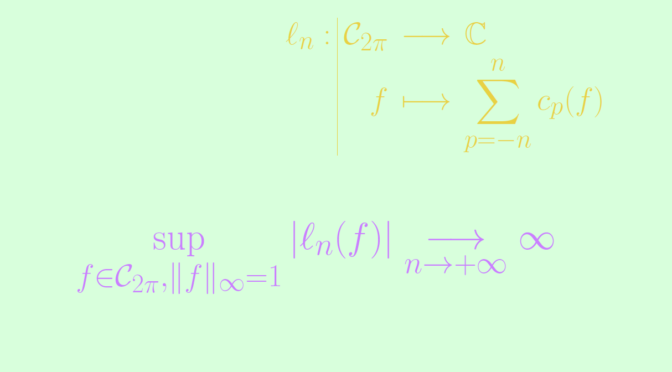In that article, I provided an example of a continuous function with divergent Fourier series. We prove here the existence of such a function using Banach-Steinhaus theorem, also called uniform boundedness principle.
Theorem (Uniform Boundedness Theorem) Let \((X, \Vert \cdot \Vert_X)\) be a Banach space and \((Y, \Vert \cdot \Vert_Y)\) be a normed vector space. Suppose that \(F\) is a set of continuous linear operators from \(X\) to \(Y\). If for all \(x \in X\) one has \[
\sup\limits_{T \in F} \Vert T(x) \Vert_Y \lt \infty\] then \[
\sup\limits_{T \in F, \ \Vert x \Vert = 1} \Vert T(x) \Vert_Y \lt \infty\]
Let’s take for \(X\) the vector space \(\mathcal C_{2 \pi}\) of continuous functions from \(\mathbb R\) to \(\mathbb C\) which are periodic with period \(2 \pi\) endowed with the norm \(\Vert f \Vert_\infty = \sup\limits_{- \pi \le t \le \pi} \vert f(t) \vert\). \((\mathcal C_{2 \pi}, \Vert \cdot \Vert_\infty)\) is a Banach space. For the vector space \(Y\), we take the complex numbers \(\mathbb C\) endowed with the modulus.
For \(n \in \mathbb N\), the map \[
\begin{array}{l|rcl}
\ell_n : & \mathcal C_{2 \pi} & \longrightarrow & \mathbb C \\
& f & \longmapsto & \displaystyle \sum_{p=-n}^n c_p(f) \end{array}\] is a linear operator, where for \(p \in \mathbb Z\), \(c_p(f)\) denotes the complex Fourier coefficient \[
c_p(f) = \frac{1}{2 \pi} \int_{- \pi}^{\pi} f(t) e^{-i p t} \ dt\]
We now prove that
\begin{align*}
\Lambda_n &= \sup\limits_{f \in \mathcal C_{2 \pi}, \Vert f \Vert_\infty=1} \vert \ell_n(f) \vert\\
&= \frac{1}{2 \pi} \int_{- \pi}^{\pi} \left\vert \frac{\sin (2n+1)\frac{t}{2}}{\sin \frac{t}{2}} \right\vert \ dt = \frac{1}{2 \pi} \int_{- \pi}^{\pi} \left\vert h_n(t) \right\vert \ dt,
\end{align*} where one can notice that the function \[
\begin{array}{l|rcll}
h_n : & [- \pi, \pi] & \longrightarrow & \mathbb C \\
& t & \longmapsto & \frac{\sin (2n+1)\frac{t}{2}}{\sin \frac{t}{2}} &\text{for } t \neq 0\\
& 0 & \longmapsto & 2n+1
\end{array}\] is continuous.
Using the trigonometric equality \[
\displaystyle \sum_{p=-n}^n e^{-i p t} = \frac{\sin (2n+1)\frac{t}{2}}{\sin \frac{t}{2}}\] we get for \(f \in \mathcal C_{2 \pi}\)
\begin{align*}
\ell_n(f) &= \displaystyle \sum_{p=-n}^n c_p(f) = \frac{1}{2 \pi} \displaystyle \sum_{p=-n}^n \int_{- \pi}^{\pi} f(t) e^{-i p t} \ dt\\
&= \frac{1}{2 \pi} \int_{- \pi}^{\pi} \displaystyle f(t) \left(\sum_{p=-n}^n e^{-i p t} \right) \ dt\\
&= \frac{1}{2 \pi} \int_{- \pi}^{\pi} f(t) \frac{\sin (2n+1)\frac{t}{2}}{\sin \frac{t}{2}} \ dt = \frac{1}{2 \pi} \int_{- \pi}^{\pi} f(t) h_n(t) \ dt
\end{align*} hence the inequality \[
\Lambda_n \le \frac{1}{2 \pi} \int_{- \pi}^{\pi} \left\vert \frac{\sin (2n+1)\frac{t}{2}}{\sin \frac{t}{2}} \right\vert \ dt.\] For \(q \in \mathbb N\) let’s note for \(t \in [-\pi,\pi]\), \(\displaystyle f_q(t) = \frac{h_n(t)}{\vert h_n(t) \vert + \frac{1}{q}}\). One can check that \(h_q \in \mathcal C_{2 \pi}\). Then denoting \(\delta_q = \left\vert \ell_n(f_q) – \frac{1}{2 \pi} \int_{- \pi}^{\pi} \vert h_n(t) \vert \ dt \right\vert\), we obtain
\begin{align*}
\delta_q & \le \frac{1}{2 \pi} \int_{- \pi}^{\pi} \left\vert \frac{h_n^2(t) – \vert h_n^2(t) \vert -\frac{1}{q}\vert h_n(t) \vert}{\vert h_n(t) \vert + \frac{1}{q}} \right\vert \ dt\\
& \le \frac{1}{2 q\pi} \int_{- \pi}^{\pi} \frac{\vert h_n(t) \vert}{\vert h_n(t) \vert + \frac{1}{q}} \ dt \le \frac{1}{q}
\end{align*} because \(h_n\) is a real function. As \(\lim\limits_{q \to \infty} \Vert f_q \Vert = 1\), following limits hold \[
\lim\limits_{q \to \infty} \ell_n(f_q/\Vert f_q \Vert) = \lim\limits_{q \to \infty} \ell_n(f_q) = \frac{1}{2 \pi} \int_{- \pi}^{\pi} \left\vert h_n(t) \right\vert \ dt\] which concludes our proof that \[
\Lambda_n = \sup\limits_{f \in \mathcal C_{2 \pi}, \Vert f \Vert_\infty=1} \vert \ell_n(f) \vert = \frac{1}{2 \pi} \int_{- \pi}^{\pi} \left\vert h_n(t) \right\vert \ dt\]
Now for all \(t \in \mathbb R\) \(\vert \sin t \vert \le \vert t \vert \) and therefore
\begin{align*}
\Lambda_n & \ge \frac{1}{2 \pi} \int_{- \pi}^{\pi} \left\vert \frac{\sin (2n+1)\frac{t}{2}}{\frac{t}{2}} \right\vert \ dt = \frac{2}{\pi} \int_0^{\pi} \left\vert \frac{\sin (2n+1)\frac{t}{2}}{t} \right\vert \ dt\\
& \ge \frac{2}{\pi} \int_0^{(2n+1)\frac{\pi}{2}} \frac{\vert \sin u \vert}{u} \ du
\end{align*}
As it is known that \(\lim\limits_{x \to \infty} \int_0^x \frac{\vert \sin u \vert}{u} \ du = \infty\) we get \[
\lim\limits_{n \to \infty} \Lambda_n = \infty\] This is were Banach-Steinhaus theorem comes into play. The set of linear continuous operators \(F=\{\ell_n \ ; \ n \in \mathbb N\}\) is such that \[
\sup\limits_{\ell \in F, \ \Vert f \Vert_\infty = 1} \vert \ell(f) \vert = \infty.\] Therefore it exists \(f_0 \in \mathcal C_{2 \pi}\) such that \(\sup\limits_{n \in \mathbb N} \vert \ell_n(f_0) \vert = \infty\). It implies that the Fourier series of \(f_0\) diverges at \(0\) as if it was converging the sequence \((\ell_n(f_0))\) would be bounded.


One thought on “Existence of a continuous function with divergent Fourier series”